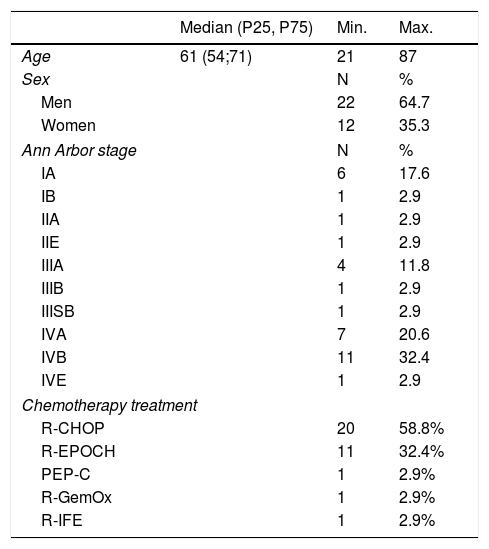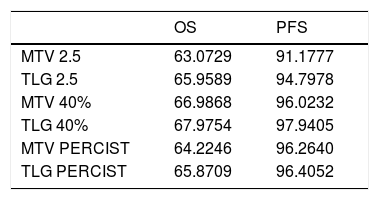Metabolic tumor volume (MTV) is a promising indicator of prognosis in diffuse large B-cell lymphoma (DLBCL). The aim of the present study is to evaluate the different methods for the calculation of the basal metabolic tumor volume with 18F-fluorodeoxyglucose (18F-FDG) positron emission tomography/computed tomography (PET/CT) in the patients with DLBCL, relating each one of the volumes measured with progression-free survival (PFS) and overall survival (OS).
MethodologyThis is a retrospective analytical cohort study, in which 34 patients underwent to 18F-FDG PET/CT baseline prior to treatment. We compared three SUV thresholds 2.5, SUV 40% of the maximum SUV and SUV mean hepatic uptake (PERCIST) for the calculation of MTV and total lesion glycolysis (TLG) biomarkers, relating them to the PFS and OS. The best predictive model was selected based on the Akaike’s information criterion (AIC) after performing a Cox proportional hazards regression.
ResultsIn relation to the PFS, they show statistically significant differences: MTV 2.5, TLG 2.5, MTV 40, TLG 40, MTV and TLG calculated with the PERCIST threshold. Among these, the one that has a lower AIC is MTV 2.5, so it is considered the best parameter to predict the PFS. With respect to OS, it shows statistically significant differences: MTV 2.5, VMT and TLG calculated with the PERCIST threshold. Among these three, the one with the lowest AIC is MTV 2.5, which is why it is considered the best parameter to predict OS. In addition, a higher value of MTV and total tumor glycolysis (TLG), is associated with worse PFS and OS.
ConclusionThe MTV calculated with the threshold SUV 2.5 seems to be the best parameter to predict PFS and OS in patients diagnosed with DLBCL with 18F-FDG PET/CT.
El volumen metabólico tumoral (VMT) es un indicador de pronóstico prometedor en el linfoma B difuso de células grandes (LBDCG). El objetivo del presente estudio es evaluar los diferentes métodos para el cálculo del VMT basal con la tomografía por emisión de positrones/tomografía computarizada con 18F-fluorodesoxiglucosa (18F-FDG PET/TC) en pacientes con LBDCG, relacionando cada uno de los volúmenes medidos con la supervivencia libre de progresión (SLP) y la supervivencia general (SG).
MetodologíaSe trata de un estudio de cohortes retrospectivo analítico, en el que se incluyeron 34 pacientes sometidos a un 18F-FDG PET/TC basal previo al tratamiento. Comparamos tres umbrales SUV 2,5, SUV 40% del SUV máximo y SUV medio hepático (PERCIST), para el cálculo de los biomarcadores VMT y glucólisis total de la lesión (TLG) relacionándolos con la SLP y SG. El mejor modelo predictivo se seleccionó en función del valor de criterio de información de Akaike (AIC) después de realizar una regresión de riesgos proporcionales de Cox.
ResultadosCon relación a la SLP, muestran diferencias estadísticamente significativas: VMT 2,5, TLG 2,5, VMT 40%, TLG 40%, VMT y TLG calculados con el umbral PERCIST. Entre estos, el que tiene un AIC menor es VMT 2,5, por lo que se considera el mejor parámetro para predecir la SLP. Con respecto a la SG, muestra diferencias estadísticamente significativas: VMT 2,5, VMT y TLG calculados con el umbral PERCIST. Entre estos tres, el que tiene un AIC menor es VMT 2,5, por lo que se considera el mejor parámetro para predecir la SG. Además, un mayor valor de VMT y TLG, se asocia a peor SLP y SG.
ConclusiónEl VMT calculado con el umbral SUV 2,5 parece ser el mejor parámetro para predecir la SLP y SG en los pacientes diagnosticados con LBDCG con el 18F-FDG PET/TC.
Article
If you experience access problems, you can contact the SEMNIM Technical Secretariat by email at secretaria.tecnica@semnim.es or by phone at +34 619 594 780.

Revista Española de Medicina Nuclear e Imagen Molecular (English Edition)












